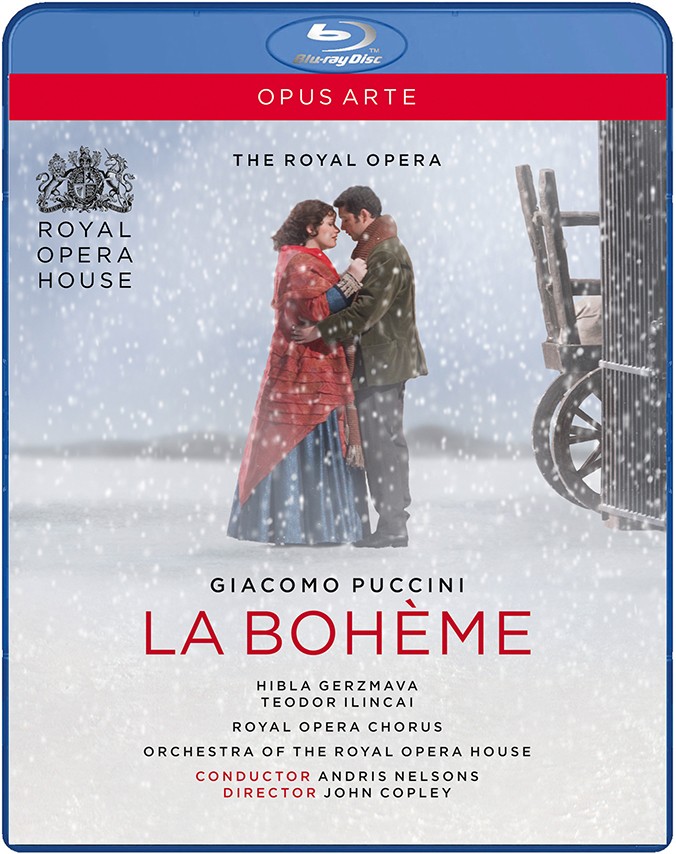

Puccini La Bohème opera to a libretto by Luigi Illica and Giuseppe Giacosa. Directed 2009 by John Copley at the Royal Opera House. Stars Teodor Ilincai (Rodolfo), Hibla Gerzmava (Mimì), Gabriele Viviani (Marcello), Inna Dukach (Musetta), Kostas Smoriginas (Colline), Jacques Imbrailo (Schaunard), Jeremy White (Benoit), Donald Maxwell (Alcindoro), Alan Duffield (Parpignol), Bryan Secombe (Sergeant), and Jonathan Coad (Costums Officer). Andris Nelsons conducts The Orchestra of the Royal Opera House (Concert Master Peter Manning), the Royal Opera Chorus (Chorus Director Renato Balsadonna), and the Tiffin Children's Chorus (Chorus Director Simon Toyne). Designs by Julia Trevelyan Oman; lighting design by John Charlton after William Bundy. Directed for TV by Robin Lough; music direction by Frances Whitaker; produced by David Groves. Released 2010, this disc has 5.1 dts-Master Audio sound. Grade: C+
This John Copley production of La Bohème harks back to 1974. It competes now (2011) with the Del Monaco production at the Teatro Real, the Dornhelm motion picture, and Jonathan Miller's version at the ENO. These shows tend to make Copley's small, chopped-up interior sets and fussy costumes look obsolete.
All the singers are good. Alas, problems come from weak acting and/or directing. Copley does a good job of coordinating the stage movements to the text in the fast-moving scenes of banter among the 4 roommates and the dinner at Cafe Momus. But his love scenes between Rodolfo and Mimi (Acts 1 and 3) and the death scene are unsatisfying. Stout Hibla Gerzmava has neither the looks or acting ability to be convincing as Mimì. Teodor Ilincai as Rodolfo too often looks bored. They spend much of their love scenes standing 5 to 15 feet apart singing (quite well) to the audience as if at recital. (Contrast this to Del Monaco's heart-wrenching Act 3 reconciliation scene where he has Inva Mula and Aquiles Machado huddled under a small blanket.) In Act 4, Gerzmava gets out of her death bed and walks to some steps to sit for a while. She then walks back and stays propped up on a big pillow until it's time to die. Why all this coming and going? (This line comes from the libretto.)
La Bohème has two love stories: Mimì is the girl who dies and Musetta is the one who lives. So a good La Bohème must have a good Musetta. Inna Dukach has a great voice for Musetta and is beautiful in still photographs. But her overacting, rubber mouth, and tendency to make faces result in some startling moments in this show.
We wonder how many times the folks in the pit at the Royal Opera House have played La Bohème? Would this eventually gets tiresome? Well, to pep things up, get a new conductor. Young Andris Nelsons is a perfect choice to get the players' attention. When he starts a piece, he looks like a panther getting set to leap on theWe couldn't find a YouTube clip worth including here. head of concert master. Another odd thing about this recording is that there seems to be a lot of empty seats in the house. We get the impression that every opera lover in England has already seen this production. Could it be that this show was in 2009 being used as a tourist trap?
In summary, at this writing, the Del Monaco Teatro Real La Bohème is still the King of the Mountain. We don't see any reason to get this ROH version unless you want a record of the Copley sets and costumes or have a special interest in the singers, etc. So we give this title the grade of "C+.
OR
